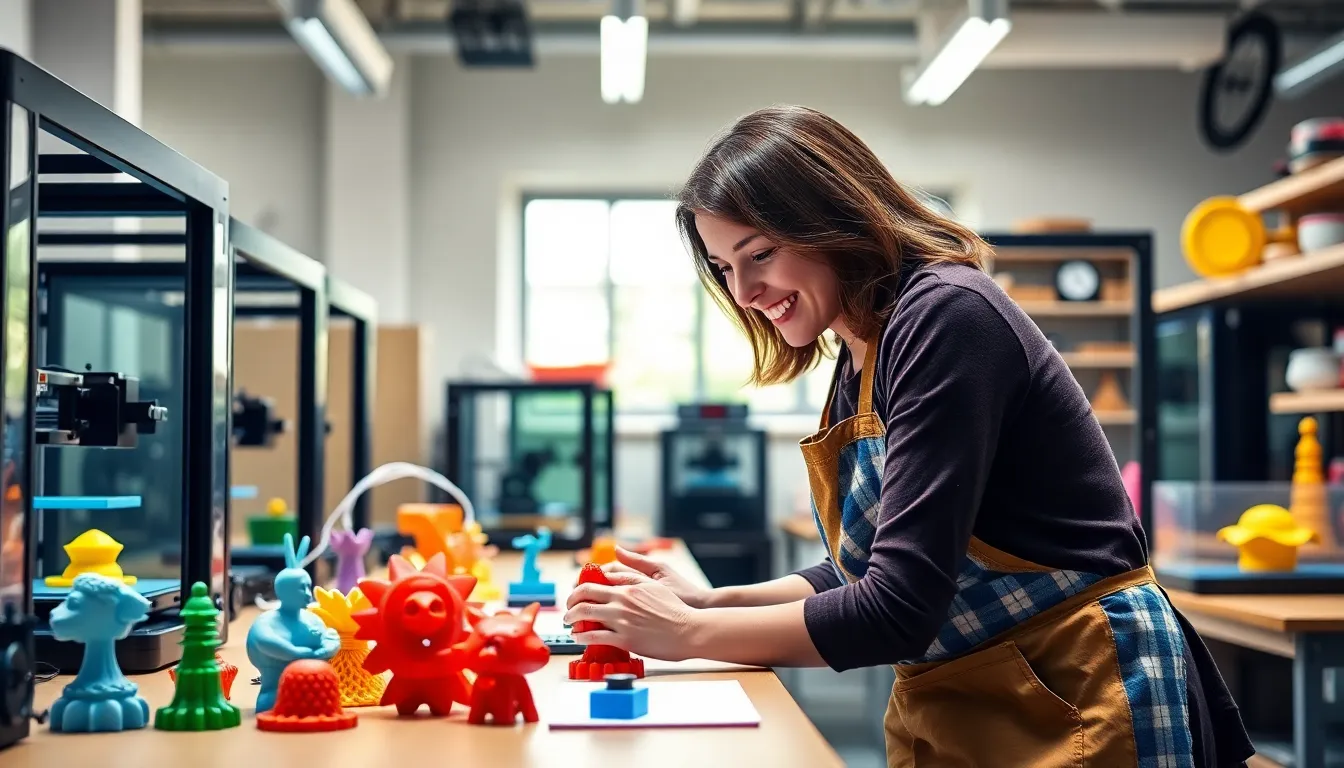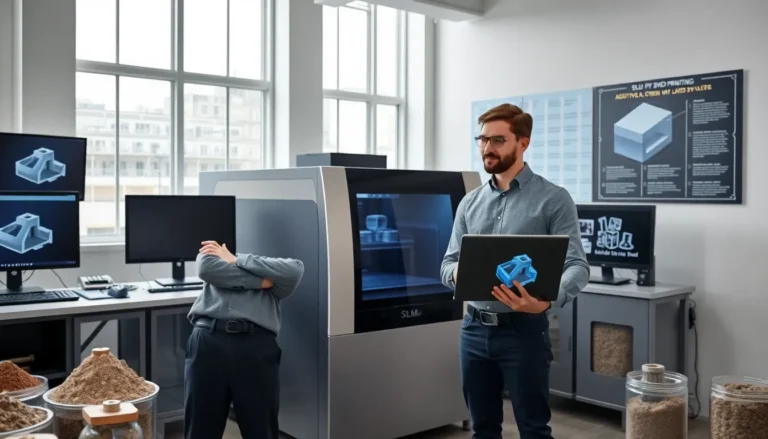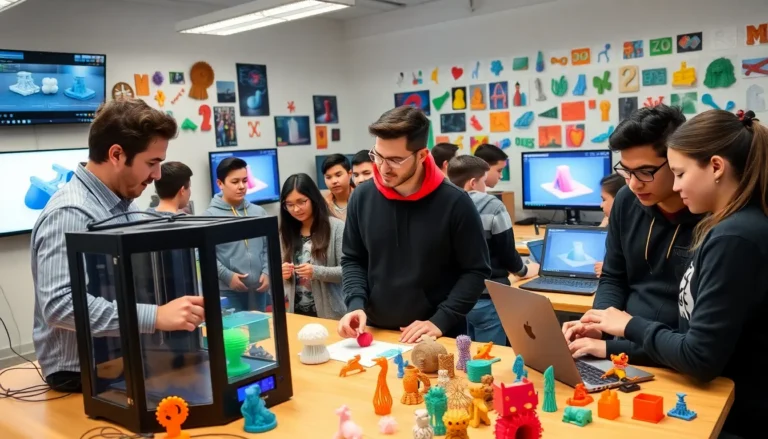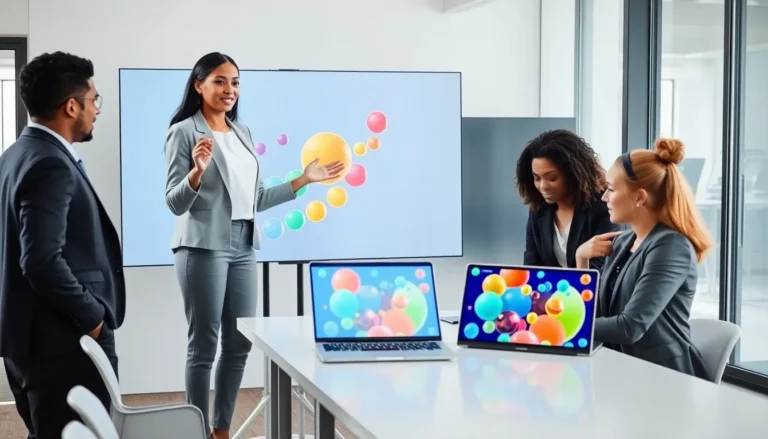Table of Contents
ToggleIn a world where creativity knows no bounds, immersive 3D printing experiences are taking the stage like a rockstar at a sold-out concert. Imagine stepping into a realm where ideas morph into tangible objects right before your eyes. It’s not just printing; it’s a magic show where the rabbit is a custom-designed phone case and the hat is a fully functional drone.
These experiences are revolutionizing how people interact with technology, blending art and engineering in a delightful dance. Whether you’re a seasoned designer or someone who can barely draw a stick figure, the allure of 3D printing is irresistible. Get ready to unleash your inner inventor and dive into a world where the only limit is your imagination. Who knew that creating your own masterpiece could be this fun?
Overview of Immersive 3D Printing Experiences
Immersive 3D printing experiences provide a unique interaction where creativity meets technology. These experiences allow participants to witness the transformation of ideas into tangible items. Engagement becomes personal as individuals manipulate software to design their creations seamlessly.
Many users experience a sense of empowerment, as they can produce custom designs that reflect their personalities and visions. Workshops and events demonstrate the practical aspects of 3D printing while encouraging collaboration and exploration among attendees. Various platforms offer hands-on sessions, where users can learn about different printing materials, techniques, and applications.
Art and engineering come together harmoniously in these immersive environments. Virtual reality (VR) and augmented reality (AR) enhance the experience further, helping users visualize their projects in real time. Participants find themselves navigating digital landscapes filled with endless possibilities, integrating their designs with virtual elements seamlessly.
Learning opportunities abound within these settings. Users gain insights into the mechanics of 3D printing, the importance of design specifications, and the implications of sustainable materials. Such knowledge not only enriches one’s understanding of the technology but also fosters a sense of responsibility toward ecological practices.
As more people engage with immersive 3D printing continuously, innovation is expected to flourish. The community surrounding this technology grows, facilitating shared learning experiences and collaborative projects. Overall, immersive 3D printing experiences invite individuals from different backgrounds to explore their creative potential and deepen their understanding of modern manufacturing.
Benefits of Immersive 3D Printing

Immersive 3D printing experiences offer numerous advantages that enhance creativity and collaboration. These benefits shape how participants engage with technology and each other.
Enhanced User Engagement
Immersive experiences capture users’ attention effectively. Participants are drawn into a hands-on environment that promotes active involvement. Engagement increases as users interact with digital tools and create unique designs. Additionally, the combination of VR and AR adds an extra layer of excitement, allowing individuals to visualize their projects instantly. Engaging workshops encourage collaboration, sharing insights among peers. Empowered by an interactive atmosphere, users explore their creativity and experiment with different ideas. Overall, an enhanced experience fosters a strong connection between users and their creations.
Real-Time Problem Solving
Immersive 3D printing allows users to address challenges immediately. Participants face obstacles in design or printing and resolve them on the spot. Accessing resources and guidance makes troubleshooting easier while working on projects. Real-time interactions stimulate collaborative problem-solving, as participants can discuss ideas and solutions with others. This dynamic fosters a culture of innovation, encouraging individuals to think critically and adapt. With immediate feedback and support, users develop skills that enhance their projects’ success. Real-time problem solving empowers participants to take creative risks and improve their expertise in 3D printing.
Technologies Behind Immersive 3D Printing
Immersive 3D printing experiences rely on advanced technologies that redefine how users interact with design and manufacturing. Key among these are virtual reality and augmented reality, which enhance user engagement and creativity.
Virtual Reality Integration
Virtual reality (VR) creates immersive environments where users explore and manipulate 3D designs in a simulated space. Participants engage actively with their creations, allowing for a deeper understanding of spatial relationships and design mechanics. By using VR headsets, individuals can visualize their projects from various angles, offering unprecedented insight into their designs. This technology fosters an environment of experimentation, enabling users to iterate and refine their ideas virtually before physical printing. Real-time feedback enhances the design process, making it easier to identify and solve problems swiftly.
Augmented Reality Applications
Augmented reality (AR) enhances the design experience by overlaying digital information on the real world. Users can visualize their 3D models in real-time, directly within their environment. This interaction allows for precise adjustments and better decision-making during design processes. With AR applications, individuals can assess the scale and fit of their creations, ensuring designs meet their expectations before printing. Collaboration becomes seamless as users share their augmented experiences with others, facilitating group discussions and innovative brainstorming. Through AR, participants blend physical and digital realms, transforming how they perceive and create objects.
Case Studies of Immersive 3D Printing
Immersive 3D printing experiences have emerged across various sectors, showcasing their transformative impact. The following case studies illustrate their effectiveness in different environments.
Educational Institutions
Educational institutions leverage immersive 3D printing to engage students in hands-on learning. Schools and universities introduce workshops where students design and create their models. Through interactive lessons, they gain insights into design principles and printing technologies. In workshops, educators utilize VR to simulate design environments, allowing for exploration and experimentation. Students collaborate on projects, enhancing teamwork and creativity. The integration of AR helps visualize concepts in real time, increasing comprehension. Programs often lead to increased student interest in STEM subjects, fostering future innovations in engineering and technology.
Industrial Applications
Industries embrace immersive 3D printing to optimize product development. Companies engage employees in design sessions using VR to enhance prototyping processes. This technology enables real-time feedback and rapid iterations, streamlining workflows. Organizations frequently conduct training programs focused on the mechanics of 3D printing, enhancing operational efficiency. Teams collaborate on complex models, fostering innovation within various departments. AR applications allow for precise measurements and adjustments during the design phase, minimizing errors. Businesses that adopt these practices often report faster product launches and improved quality control, positioning them competitively in the market.
Future Trends in Immersive 3D Printing Experiences
Continuous advancements in immersive 3D printing technologies shape the future of creative engagement. Increased integration of artificial intelligence enhances personalized design experiences by offering tailored suggestions based on user preferences. Emerging materials, such as bioplastics and recycled composites, will promote sustainable practices in 3D printing, appealing to environmentally conscious creators.
In educational settings, immersive experiences are set to become mainstream, transforming classrooms into interactive learning hubs. Workshops focusing on innovative design methodologies will engage students and emphasize real-world applications. Collaboration among educators, industry leaders, and technology developers is expected to create comprehensive curricula that effectively prepare students for future careers in engineering and design.
The rise of cross-platform applications will facilitate seamless sharing and collaboration in immersive 3D printing. Users can connect across multiple devices, allowing for real-time feedback and input from remote collaborators. This capability will further enrich the collaborative atmosphere and broaden community engagement.
Moreover, advancements in VR and AR will evolve user interfaces, making them more intuitive and accessible for a wider range of participants. Enhanced immersion will allow users to visualize their projects more realistically and refine designs with greater accuracy. This shift will welcome non-experts into the immersive 3D printing community.
Data analytics will play a crucial role in understanding user engagement and preferences. Analyzing participation metrics will inform creators about trends and demands, guiding future developments. As these trends continue to unfold, the landscape of immersive 3D printing experiences will expand, fostering a vibrant ecosystem of innovation and creativity.
Immersive 3D printing experiences are reshaping the landscape of creativity and technology. By blending art with engineering, they empower individuals to bring their ideas to life in engaging ways. As participants explore design and innovation through workshops and interactive environments, they’re not just learning; they’re becoming part of a vibrant community.
The integration of VR and AR technologies enhances these experiences, making them more accessible and intuitive. As advancements continue, the potential for personalized design and sustainable practices will only grow. Immersive 3D printing isn’t just a trend; it’s a transformative movement that invites everyone to explore their creativity and collaborate in exciting new ways.







